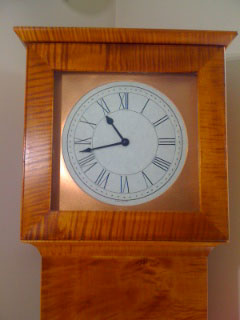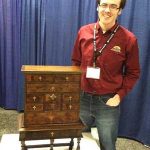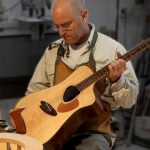We may receive a commission when you use our affiliate links. However, this does not impact our recommendations.
 Back in the last century (in 1999) I built a Shaker tall clock similar to one made by famous Shaker clockmaker brother Benjamin Youngs. It was a Popular Woodworking Magazine project that has since found a permanent place in our home, giving me the opportunity to observe how it has aged.
Back in the last century (in 1999) I built a Shaker tall clock similar to one made by famous Shaker clockmaker brother Benjamin Youngs. It was a Popular Woodworking Magazine project that has since found a permanent place in our home, giving me the opportunity to observe how it has aged.
When I built it, there were a couple elements (at least), that were certainly not true to the original. Of particular interest to me were, and remain, the clock face and copper that surround it. When I completed the clock years ago, I wondered how these elements would hold up. I was concerned that the copper would tarnish and take on a dark brown patina. I drew the face itself using ink and a family heirloom set of draftsmen tools. The ink was laid down on parchment.
Today, both look as good as the day they were installed. Needless to say, drawing the face using the old set of tools gives this project special meaning to me. And the copper actually enhances the face by framing it in a warm glow of reflected light, not unlike a gilded frame on a work of art. I’d highly recommend you use, as inlay or other decorative elements, copper or other metals in your projects where appropriate. Copper sheet goods, brass and aluminum are easy to work and readily available.
On this project, I cut the round opening in the copper using a router and circle cutting jig. Just tape down the copper along its outside edges so it doesn’t move. After it was cut out, I used a random orbit sander with #220-grit sandpaper to produce a satin sheen. Lastly, a brushed on a couple thin coats of shellac to coat the metal and prevent tarnish – just don’t leave any oily fingerprints after sanding and before sealing. As I said, the original finish has held up very well.
The only bad thing about the clock, according to my dear wife, is the constant tick-tock and chiming that calls out the hours. Like so many things in 40+ years of marriage a compromise was reached – I removed the bell striker. The tick-tock remains, of course. Personally, I don’t mind the sound’s reminder that time is always marching on.
Get a digital copy of the September, 1999 issue in which the Shaker Tall Clock project was featured.
You may also want to check out “How to Build Shaker Furniture” by Thomas Moser, which includes 45 projects.
Here are some supplies and tools we find essential in our everyday work around the shop. We may receive a commission from sales referred by our links; however, we have carefully selected these products for their usefulness and quality.










Steve,
Which issue was that in and is it available? My wife wants a tall clock and that design appeals to me. Would like to see what it takes to build.
Nice little story, Steve. Your writing’s right up there with your woodworking. More please.
Nice looking clock Steve. I like the simple lines. My wife is the same way regarding sounds with a mechanical origin.
http://www.woodworkingwithajo.com